check oil FIAT IDEA 2007 1.G Owners Manual
[x] Cancel search | Manufacturer: FIAT, Model Year: 2007, Model line: IDEA, Model: FIAT IDEA 2007 1.GPages: 314, PDF Size: 4.78 MB
Page 40 of 314
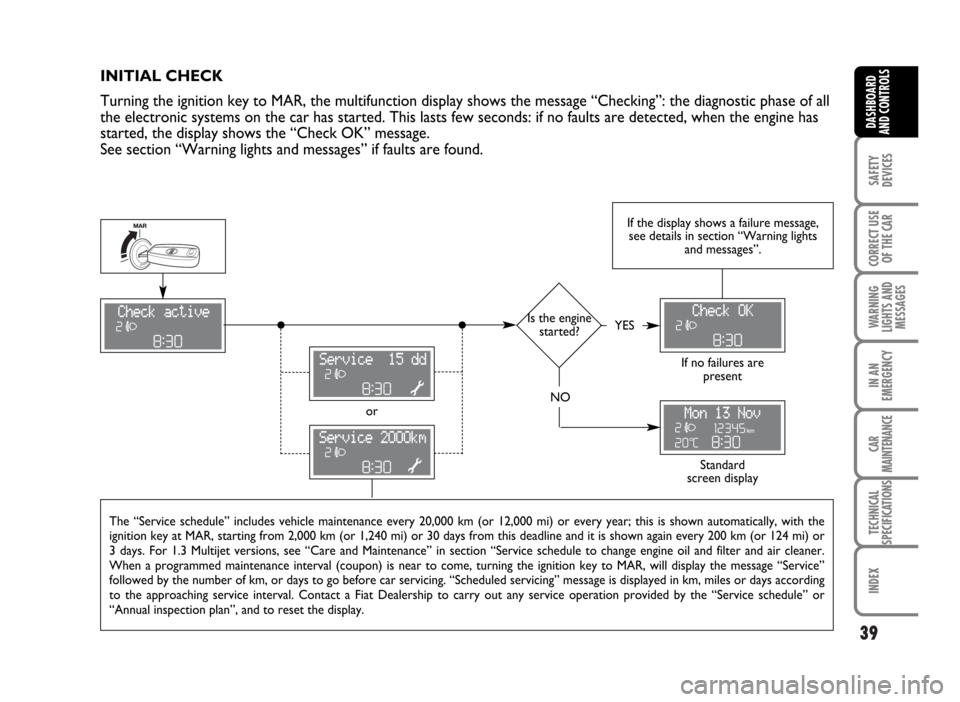
39
SAFETY
DEVICES
CORRECT USE
OF THE CAR
WARNING
LIGHTS AND
MESSAGES
IN AN
EMERGENCY
CAR
MAINTENANCE
TECHNICAL
SPECIFICATIONS
INDEX
DASHBOARD
AND CONTROLS
INITIAL CHECK
Turning the ignition key to MAR, the multifunction display shows the message “Checking”: the diagnostic phase of all
the electronic systems on the car has started. This lasts few seconds: if no faults are detected, when the engine has
started, the display shows the “Check OK” message.
See section “Warning lights and messages” if faults are found.
Is the engine
started?YES
If no failures are
present
The “Service schedule” includes vehicle maintenance every 20,000 km (or 12,000 mi) or every year; this is shown automatically, with the
ignition key at MAR, starting from 2,000 km (or 1,240 mi) or 30 days from this deadline and it is shown again every 200 km (or 124 mi) or
3 days. For 1.3 Multijet versions, see “Care and Maintenance” in section “Service schedule to change engine oil and filter and air cleaner.
When a programmed maintenance interval (coupon) is near to come, turning the ignition key to MAR, will display the message “Service”
followed by the number of km, or days to go before car servicing. “Scheduled servicing” message is displayed in km, miles or days according
to the approaching service interval. Contact a Fiat Dealership to carry out any service operation provided by the “Service schedule” or
“Annual inspection plan”, and to reset the display.
If the display shows a failure message,
see details in section “Warning lights
and messages”.
Standard
screen display or
NO
Page 130 of 314
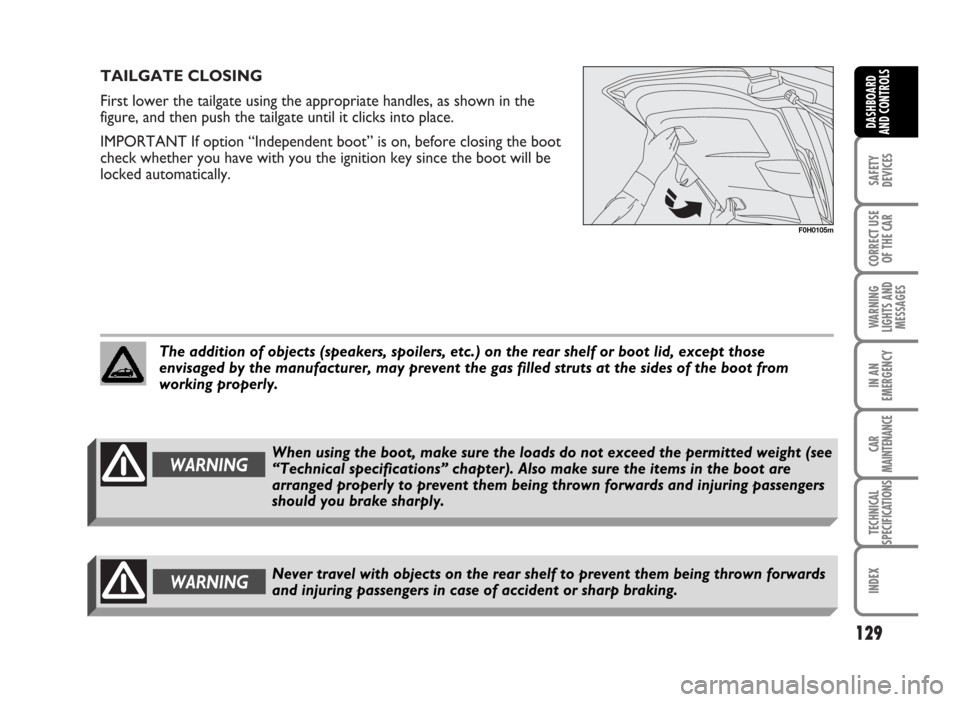
TAILGATE CLOSING
First lower the tailgate using the appropriate handles, as shown in the
figure, and then push the tailgate until it clicks into place.
IMPORTANT If option “Independent boot” is on, before closing the boot
check whether you have with you the ignition key since the boot will be
locked automatically.
129
SAFETY
DEVICES
CORRECT USE
OF THE CAR
WARNING
LIGHTS AND
MESSAGES
IN AN
EMERGENCY
CAR
MAINTENANCE
TECHNICAL
SPECIFICATIONS
INDEX
DASHBOARD
AND CONTROLS
F0H0105m
The addition of objects (speakers, spoilers, etc.) on the rear shelf or boot lid, except those
envisaged by the manufacturer, may prevent the gas filled struts at the sides of the boot from
working properly.
WARNING
WARNINGWhen using the boot, make sure the loads do not exceed the permitted weight (see
“Technical specifications” chapter). Also make sure the items in the boot are
arranged properly to prevent them being thrown forwards and injuring passengers
should you brake sharply.
Never travel with objects on the rear shelf to prevent them being thrown forwards
and injuring passengers in case of accident or sharp braking.
Page 144 of 314

ACCESSORIES PURCHASED BY
THE OWNER
If, after buying the car, you decide to install electrical
accessories that require a permanent electric supply
(alarm, satellite antitheft system, etc.) or accessories that
in any case burden the electric supply, contact Fiat
Dealership, whose qualified personnel, besides suggesting
the most suitable devices belonging to Lineaccessori Fiat,
will also evaluate the overall electric absorption,
checking whether the vehicle electric system is able to
withstand the load required, or whether it needs to be
integrated with a more powerful battery.
INSTALLATION OF ELECTRIC/
ELECTRONIC DEVICES
Electric/electronic devices installed after buying the car
or in aftermarket shall bear the and marking:
Fiat Auto S.p.A. authorizes the installation of
transceivers provided that installation is carried out at
a specialized shop, workmanlike performed and in
compliance with manufacturer's specifications.
IMPORTANT Installation of devices resulting in
modifications of car characteristics may cause driving
license seizing by traffic agents and also the lapse of
143
SAFETY
DEVICES
CORRECT USE
OF THE CAR
WARNING
LIGHTS AND
MESSAGES
IN AN
EMERGENCY
CAR
MAINTENANCE
TECHNICAL
SPECIFICATIONS
INDEX
DASHBOARD
AND CONTROLS
WARNINGBe careful when mounting additional spoilers, alloy rims and non original wheel
caps: they may reduce the brake ventilation and efficiency during sharp and
repeated braking or sloping downhill. Also make sure that nothing (over-carpeting,
etc.) interferes with the pedal stroke.
the warranty as concerns defects due to the
abovementioned modification or traceable back to it
directly or indirectly.
Fiat Auto S.p.A. declines all responsibility for damages
caused by the installation of non-genuine accessories
or not recommended by Fiat Auto S.p.A. and installed
not in compliance with the specified requirements.
RADIO TRANSMITTERS AND CELLULAR
TELEPHONES
Radio transceiver equipment (e.g.: e-tacs mobile
phones, HAM radio systems and the like) shall not be
used inside the vehicle unless a separate aerial is
mounted on the roof.
IMPORTANT The use of similar devices inside the
passenger compartment (without separated aerial)
produces radio-frequency electromagnetic fields
which, amplified by the resonance effects inside the
passenger compartment, may cause electrical systems
equipping the vehicle to malfunction. This could
compromise safety in addition to constituting a
potential hazard for the passengers.
In addition, transmission and reception of these
devices may be affected by the shielding effect of the
vehicle body.
As concerns EC-approved mobile phones (GSM,
GPRS, UMTS), strictly comply with the instructions for
use provided by the mobile phone’s manufacturer.
Page 184 of 314
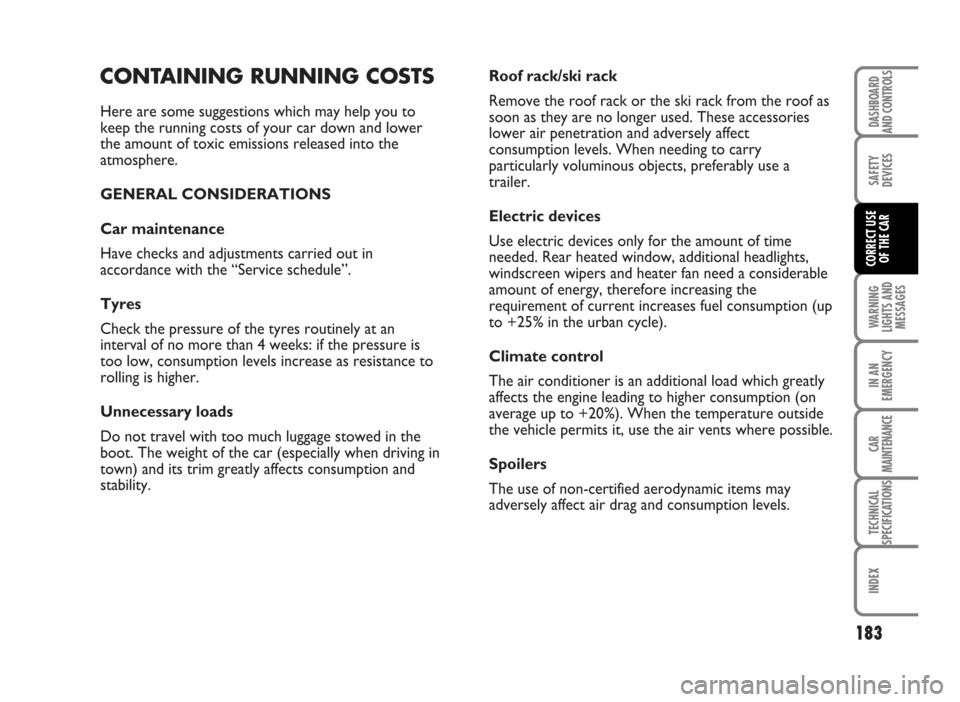
CONTAINING RUNNING COSTS
Here are some suggestions which may help you to
keep the running costs of your car down and lower
the amount of toxic emissions released into the
atmosphere.
GENERAL CONSIDERATIONS
Car maintenance
Have checks and adjustments carried out in
accordance with the “Service schedule”.
Tyres
Check the pressure of the tyres routinely at an
interval of no more than 4 weeks: if the pressure is
too low, consumption levels increase as resistance to
rolling is higher.
Unnecessary loads
Do not travel with too much luggage stowed in the
boot. The weight of the car (especially when driving in
town) and its trim greatly affects consumption and
stability.Roof rack/ski rack
Remove the roof rack or the ski rack from the roof as
soon as they are no longer used. These accessories
lower air penetration and adversely affect
consumption levels. When needing to carry
particularly voluminous objects, preferably use a
trailer.
Electric devices
Use electric devices only for the amount of time
needed. Rear heated window, additional headlights,
windscreen wipers and heater fan need a considerable
amount of energy, therefore increasing the
requirement of current increases fuel consumption (up
to +25% in the urban cycle).
Climate control
The air conditioner is an additional load which greatly
affects the engine leading to higher consumption (on
average up to +20%). When the temperature outside
the vehicle permits it, use the air vents where possible.
Spoilers
The use of non-certified aerodynamic items may
adversely affect air drag and consumption levels.
183
SAFETY
DEVICES
WARNING
LIGHTS AND
MESSAGES
IN AN
EMERGENCY
CAR
MAINTENANCE
TECHNICAL
SPECIFICATIONS
INDEX
DASHBOARD
AND CONTROLS
CORRECT USE
OF THE CAR
Page 220 of 314
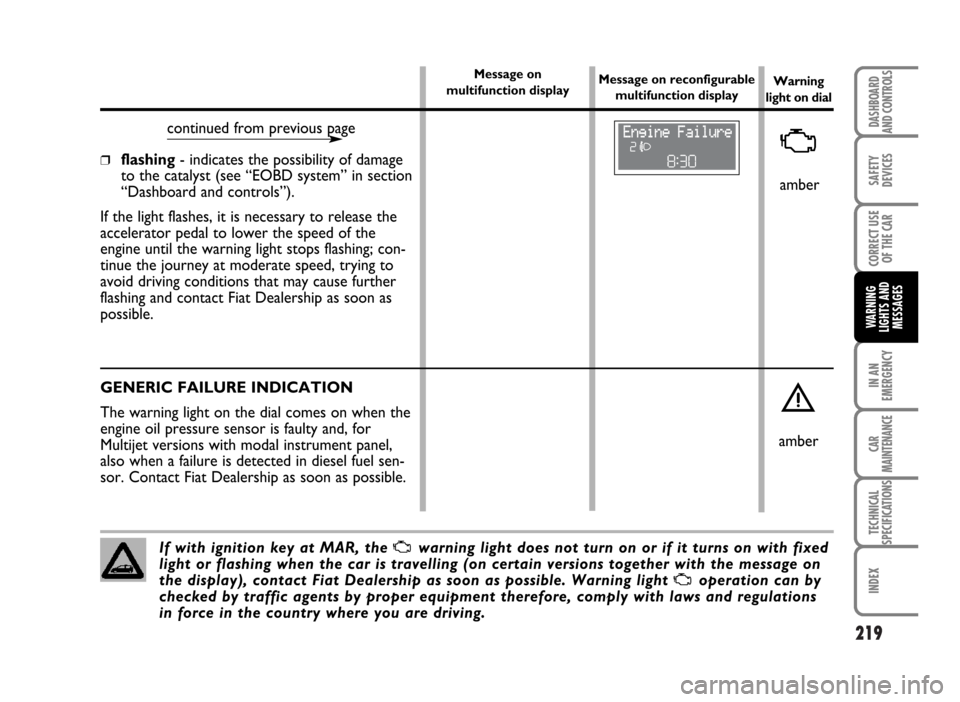
219
SAFETY
DEVICES
CORRECT USE
OF THE CAR
IN AN
EMERGENCY
CAR
MAINTENANCE
TECHNICAL
SPECIFICATIONS
INDEX
DASHBOARD
AND CONTROLS
WARNING
LIGHTS AND
MESSAGES
❒flashing- indicates the possibility of damage
to the catalyst (see “EOBD system” in section
“Dashboard and controls”).
If the light flashes, it is necessary to release the
accelerator pedal to lower the speed of the
engine until the warning light stops flashing; con-
tinue the journey at moderate speed, trying to
avoid driving conditions that may cause further
flashing and contact Fiat Dealership as soon as
possible.U
amber
amber
8:30
continued from previous page
If with ignition key at MAR, the
Uwarning light does not turn on or if it turns on with fixed
light or flashing when the car is travelling (on certain versions together with the message on
the display), contact Fiat Dealership as soon as possible. Warning light
Uoperation can by
checked by traffic agents by proper equipment therefore, comply with laws and regulations
in force in the country where you are driving.
GENERIC FAILURE INDICATION
The warning light on the dial comes on when the
engine oil pressure sensor is faulty and, for
Multijet versions with modal instrument panel,
also when a failure is detected in diesel fuel sen-
sor. Contact Fiat Dealership as soon as possible.
è
Warning
light on dial Message on
multifunction displayMessage on reconfigurable
multifunction display
Page 262 of 314
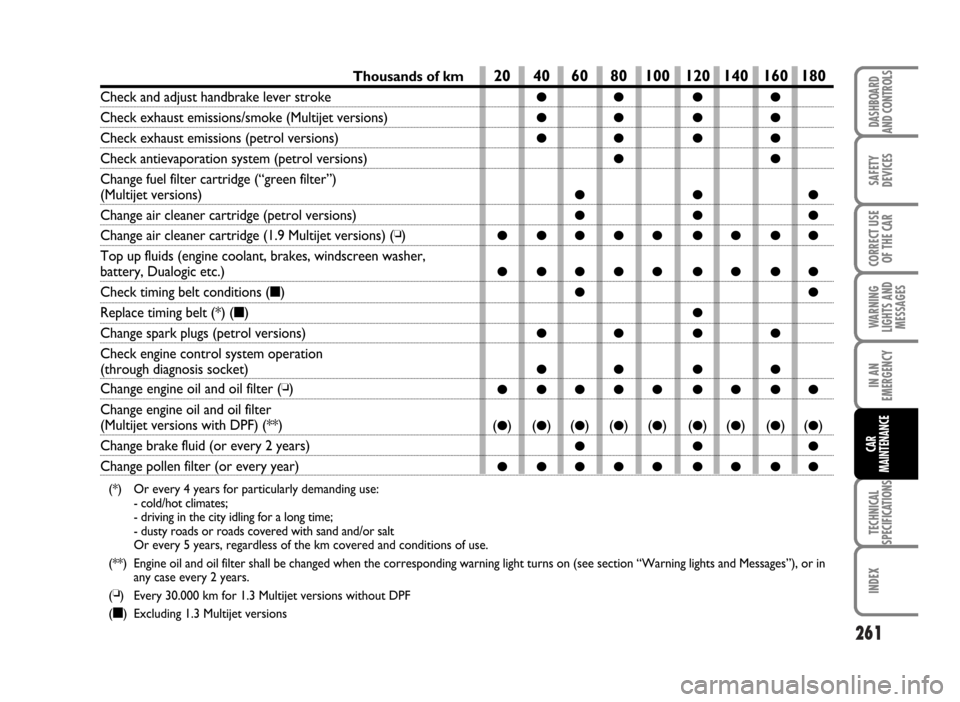
261
SAFETY
DEVICES
CORRECT USE
OF THE CAR
WARNING
LIGHTS AND
MESSAGES
IN AN
EMERGENCY
TECHNICAL
SPECIFICATIONS
INDEX
DASHBOARD
AND CONTROLS
CAR
MAINTENANCE
Thousands of km
Check and adjust handbrake lever stroke
Check exhaust emissions/smoke (Multijet versions)
Check exhaust emissions (petrol versions)
Check antievaporation system (petrol versions)
Change fuel filter cartridge (“green filter”)
(Multijet versions)
Change air cleaner cartridge (petrol versions)
Change air cleaner cartridge (1.9 Multijet versions) (❏)
Top up fluids (engine coolant, brakes, windscreen washer,
battery, Dualogic etc.)
Check timing belt conditions (■)
Replace timing belt (*) (■)
Change spark plugs (petrol versions)
Check engine control system operation
(through diagnosis socket)
Change engine oil and oil filter (❏)
Change engine oil and oil filter
(Multijet versions with DPF) (**)
Change brake fluid (or every 2 years)
Change pollen filter (or every year)
(*) Or every 4 years for particularly demanding use:
- cold/hot climates;
- driving in the city idling for a long time;
- dusty roads or roads covered with sand and/or salt
Or every 5 years, regardless of the km covered and conditions of use.
(**) Engine oil and oil filter shall be changed when the corresponding warning light turns on (see section “Warning lights and Messages”), or in
any case every 2 years.
(
❏) Every 30.000 km for 1.3 Multijet versions without DPF
(
■) Excluding 1.3 Multijet versions
20 40 60 80 100 120 140 160 180
●● ● ●
●● ● ●
●● ● ●
●●
●●●
●●●
●●●●● ●●●●
●●●●● ●●●●
●●
●
●● ● ●
●● ● ●
●●●●● ●●●●
(●)(●)(●)(●)(●)(●)(●)(●)(●)
●●●
●●●●● ●●●●
Page 263 of 314
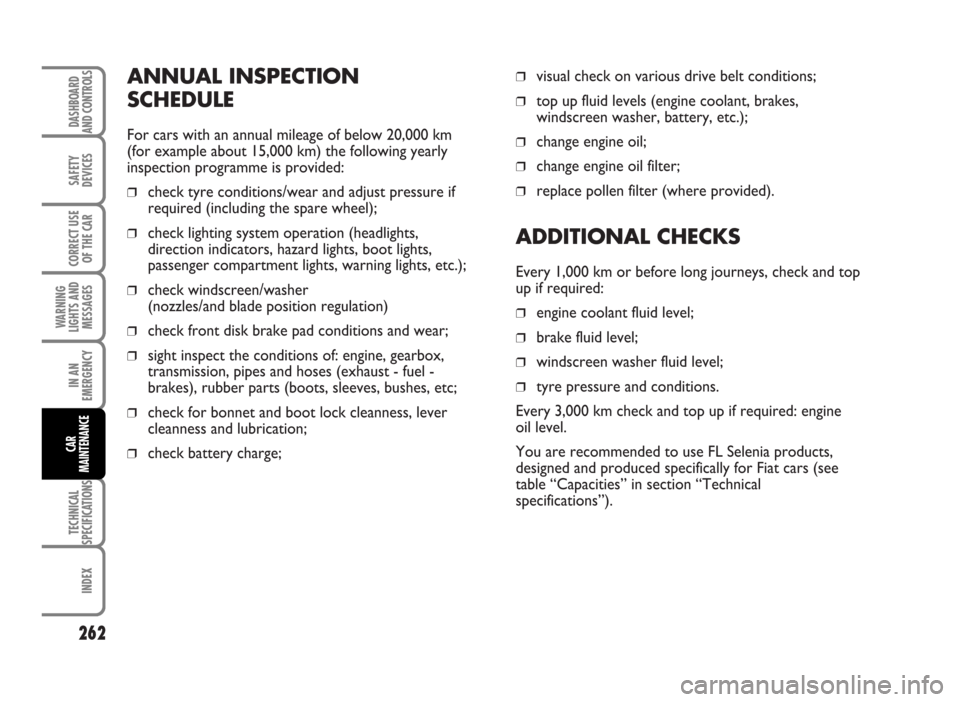
ANNUAL INSPECTION
SCHEDULE
For cars with an annual mileage of below 20,000 km
(for example about 15,000 km) the following yearly
inspection programme is provided:
❒check tyre conditions/wear and adjust pressure if
required (including the spare wheel);
❒check lighting system operation (headlights,
direction indicators, hazard lights, boot lights,
passenger compartment lights, warning lights, etc.);
❒check windscreen/washer
(nozzles/and blade position regulation)
❒check front disk brake pad conditions and wear;
❒sight inspect the conditions of: engine, gearbox,
transmission, pipes and hoses (exhaust - fuel -
brakes), rubber parts (boots, sleeves, bushes, etc;
❒check for bonnet and boot lock cleanness, lever
cleanness and lubrication;
❒check battery charge;
❒visual check on various drive belt conditions;
❒top up fluid levels (engine coolant, brakes,
windscreen washer, battery, etc.);
❒change engine oil;
❒change engine oil filter;
❒replace pollen filter (where provided).
ADDITIONAL CHECKS
Every 1,000 km or before long journeys, check and top
up if required:
❒engine coolant fluid level;
❒brake fluid level;
❒windscreen washer fluid level;
❒tyre pressure and conditions.
Every 3,000 km check and top up if required: engine
oil level.
You are recommended to use FL Selenia products,
designed and produced specifically for Fiat cars (see
table “Capacities” in section “Technical
specifications”).
262
SAFETY
DEVICES
CORRECT USE
OF THE CAR
WARNING
LIGHTS AND
MESSAGES
IN AN
EMERGENCY
TECHNICAL
SPECIFICATIONS
INDEX
DASHBOARD
AND CONTROLS
CAR
MAINTENANCE
Page 266 of 314
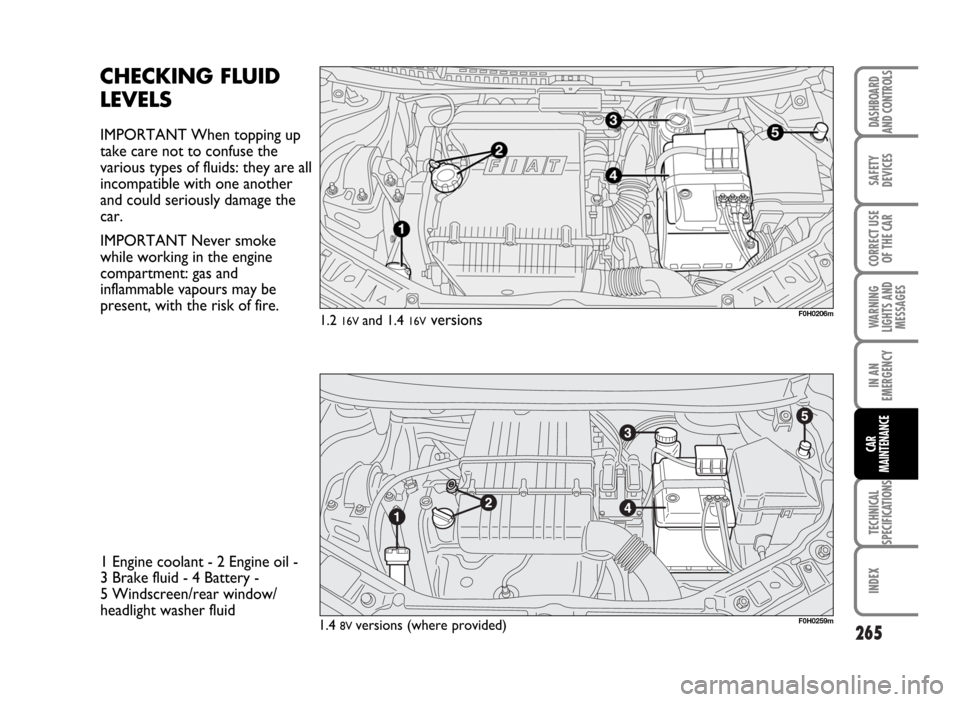
265
SAFETY
DEVICES
CORRECT USE
OF THE CAR
WARNING
LIGHTS AND
MESSAGES
IN AN
EMERGENCY
TECHNICAL
SPECIFICATIONS
INDEX
DASHBOARD
AND CONTROLS
CAR
MAINTENANCE
CHECKING FLUID
LEVELS
IMPORTANT When topping up
take care not to confuse the
various types of fluids: they are all
incompatible with one another
and could seriously damage the
car.
IMPORTANT Never smoke
while working in the engine
compartment: gas and
inflammable vapours may be
present, with the risk of fire.
1 Engine coolant - 2 Engine oil -
3 Brake fluid - 4 Battery -
5 Windscreen/rear window/
headlight washer fluid
F0H0206m1.2 16V and 1.4 16Vversions
F0H0259m1.4 8V versions (where provided)
Page 268 of 314

ENGINE OIL
Checking engine oil
Check the oil level a few minutes (about 5) after the engine has stopped,
with the car parked on level ground.
Check that the level is within the MIN and MAX marks on the dipstick.
The interval between the MIN and MAX marks corresponds to about
one litre of oil.
Topping up engine oil
If the oil level is near or even below the MIN mark, add oil through the
filler neck, until reaching the MAX mark. Oil level shall never exceed the
MAX mark.
IMPORTANT If a routine check reveals that the oil level is above the
MAX mark, contact Fiat Dealership to have the correct level restored.
IMPORTANT After adding or changing the oil, let the engine turn over
for a few seconds and wait a few minutes after turning it off before you
check the level.
267
SAFETY
DEVICES
CORRECT USE
OF THE CAR
WARNING
LIGHTS AND
MESSAGES
IN AN
EMERGENCY
TECHNICAL
SPECIFICATIONS
INDEX
DASHBOARD
AND CONTROLS
CAR
MAINTENANCE
F0H0208m
F0H0209mF0H0326m
1.2 16V - 1.4 16V versions
1.3 Multijet versions 1.9 Multijet versions
F0H0258m1.4 8V versions (where provided)
Page 285 of 314
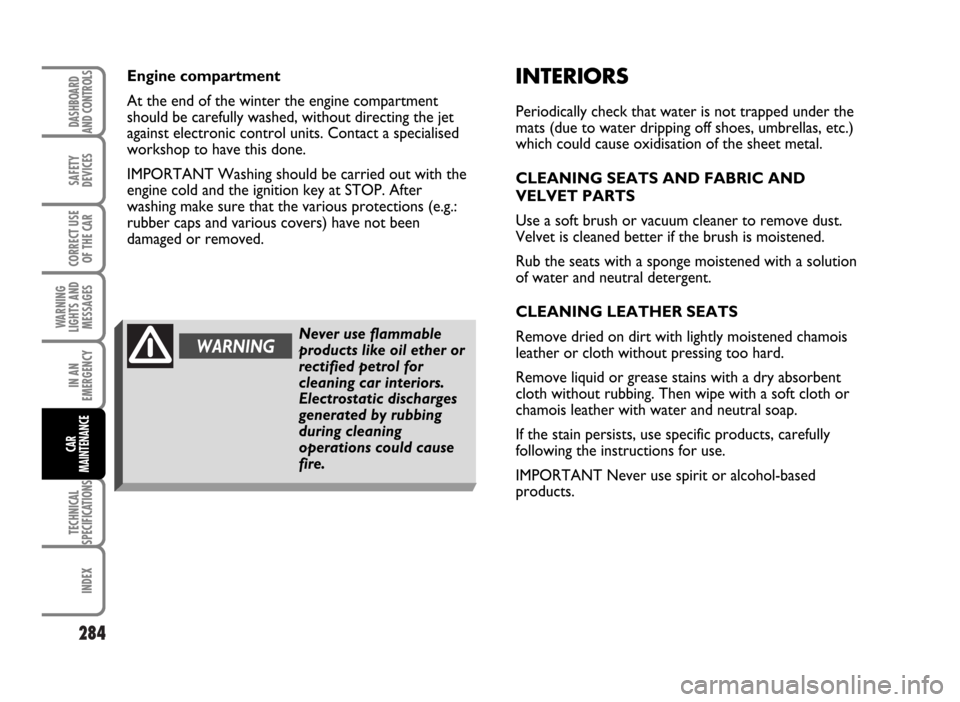
284
SAFETY
DEVICES
CORRECT USE
OF THE CAR
WARNING
LIGHTS AND
MESSAGES
IN AN
EMERGENCY
TECHNICAL
SPECIFICATIONS
INDEX
DASHBOARD
AND CONTROLS
CAR
MAINTENANCE
Engine compartment
At the end of the winter the engine compartment
should be carefully washed, without directing the jet
against electronic control units. Contact a specialised
workshop to have this done.
IMPORTANT Washing should be carried out with the
engine cold and the ignition key at STOP. After
washing make sure that the various protections (e.g.:
rubber caps and various covers) have not been
damaged or removed.INTERIORS
Periodically check that water is not trapped under the
mats (due to water dripping off shoes, umbrellas, etc.)
which could cause oxidisation of the sheet metal.
CLEANING SEATS AND FABRIC AND
VELVET PARTS
Use a soft brush or vacuum cleaner to remove dust.
Velvet is cleaned better if the brush is moistened.
Rub the seats with a sponge moistened with a solution
of water and neutral detergent.
CLEANING LEATHER SEATS
Remove dried on dirt with lightly moistened chamois
leather or cloth without pressing too hard.
Remove liquid or grease stains with a dry absorbent
cloth without rubbing. Then wipe with a soft cloth or
chamois leather with water and neutral soap.
If the stain persists, use specific products, carefully
following the instructions for use.
IMPORTANT Never use spirit or alcohol-based
products.
WARNINGNever use flammable
products like oil ether or
rectified petrol for
cleaning car interiors.
Electrostatic discharges
generated by rubbing
during cleaning
operations could cause
fire.